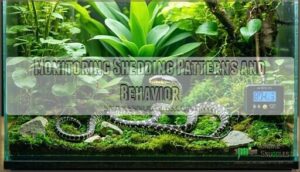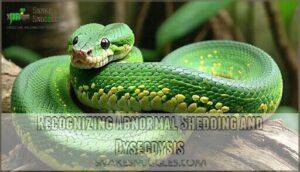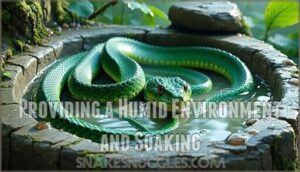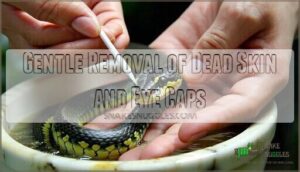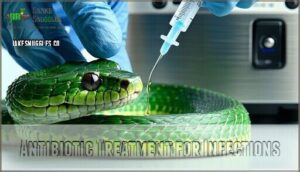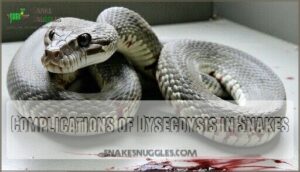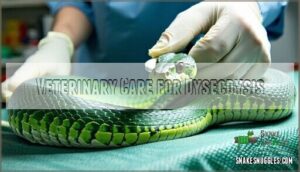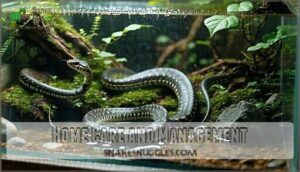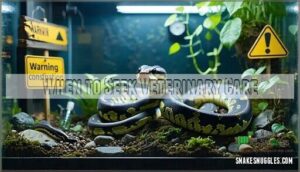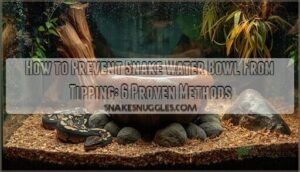This site is supported by our readers. We may earn a commission, at no cost to you, if you purchase through links.
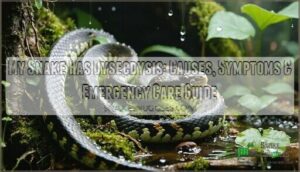
This common issue usually stems from low humidity, poor nutrition, or stress.
You’ll notice dull skin, retained eye caps, or patchy shedding that looks like your snake’s wearing a bad sweater.
Quick fixes include raising humidity to 60-80%, providing a humid hide, and gentle soaking.
Remove stuck pieces carefully with tweezers, but avoid forcing anything off.
Most cases resolve with proper care, though some situations need professional help to prevent complications.
Table Of Contents
- Key Takeaways
- What is Dysecdysis in Snakes?
- Common Causes of Dysecdysis
- How to Identify Dysecdysis in Snakes
- Treating Dysecdysis in Snakes
- Preventing Dysecdysis in Snakes
- Complications of Dysecdysis in Snakes
- Veterinary Care for Dysecdysis
- Home Care and Management
- When to Seek Veterinary Care
- Frequently Asked Questions (FAQs)
- What is Dysecdysis in snakes?
- How do you know if a snake has Dysecdysis?
- What does Dysecdysis mean in reptiles?
- Which reptiles have Dysecdysis?
- How do you treat Dysecdysis in snakes?
- How do you know if a reptile has Dysecdysis?
- What causes dysecdysis in snakes?
- How to treat dysecdysis?
- What does it mean when a snake is undergoing dysecdysis?
- What causes snakes to have diarrhea?
- Conclusion
Key Takeaways
- Increase humidity to 60-80% and provide humid hides – Low humidity is the main cause of dysecdysis, so you’ll need to boost moisture levels and give your snake a dedicated humid retreat area.
- Soak your snake in warm water and gently remove stuck skin – Give 10-15 minute soaks to soften retained skin, then carefully peel off loose pieces with your fingers or tweezers, avoiding eye caps.
- Don’t handle your snake during shedding cycles – Your snake’s skin becomes extra sensitive during the 7-10 day shedding process, so avoid touching them to prevent stress and skin damage.
- Seek veterinary care for severe cases or infections – If you notice swelling, discharge, eye damage, or your snake doesn’t improve with home treatment, you’ll need professional help to prevent serious complications.
What is Dysecdysis in Snakes?
If you’ve noticed your snake struggling with shedding, you’re dealing with dysecdysis – a common but treatable condition that happens when old skin doesn’t come off properly.
This isn’t just a cosmetic issue; it can lead to serious health problems if left untreated, especially around the eyes and tail where circulation gets cut off, which can be a result of dysecdysis.
Definition and Explanation
Snake dysecdysis is a skin-shedding malfunction where your snake’s natural molting process hits a snag. Instead of slipping out of their old skin like a sleek snake-suit, pieces get stuck. This shedding problem signals underlying conditions affecting your reptile’s health.
**When your snake’s skin becomes a prison instead of protection, dysecdysis turns shedding into a dangerous struggle.
Here’s what makes dysecdysis tick:
- Reptile ecdysis goes haywire – Normal shedding gets interrupted
- Skin buildup occurs – Dead skin accumulates on body parts
- Snake shedding issues develop – Stuck shed snake becomes uncomfortable
- Reptile symptoms emerge – Your snake shows distress signals
Causes of Dysecdysis
Understanding what triggers snake dysecdysis can help you prevent this frustrating condition.
Think of it like a perfect storm of factors that can disrupt your snake’s natural shedding process.
Several key culprits contribute to causes of dysecdysis:
- Environmental Stressors: Low humidity, incorrect temperatures, and poor lighting create stress that interferes with normal shedding cycles.
- Nutritional Imbalance: A poor diet lacking essential vitamins, especially vitamin A, weakens skin cell development and shedding mechanisms.
- Skin Trauma: Excessive handling during shedding periods or rough surfaces can damage delicate pre-shed skin.
- Parasitic Infestation & Underlying Diseases: Internal parasites and infections compromise your snake’s immune system, making healthy shedding nearly impossible.
Symptoms and Signs of Dysecdysis
Now that you know what causes dysecdysis, spotting the symptoms becomes your next priority.
Your snake’s behavior and appearance will tell the whole story if you know what to look for.
| Physical Signs | Behavioral Changes | Severity Level |
|---|---|---|
| Dull skin lacking shine | Appetite loss | Mild |
| Patchy shedding in pieces | Increased hiding | Moderate |
| Retained eyecaps | Lethargy and stress | Moderate |
| Skin buildup on toes | Excessive rubbing | Severe |
| Wrinkled, dry patches | Refusal to eat | Severe |
Snake dysecdysis symptoms range from obvious to subtle.
Incomplete shed leaves your snake looking like it’s wearing old pajamas that won’t come off.
Snake shedding problems often start with behavioral changes before physical signs appear.
Common Causes of Dysecdysis
Understanding why your snake develops dysecdysis helps you prevent future episodes and keep your pet healthy.
Most cases stem from husbandry mistakes that are easy to fix once you know what to look for.
Poor Husbandry and Management
Your snake’s enclosure size matters more than you think. A cramped tank creates stress that triggers shedding problems.
Substrate choice affects proper humidity snake levels – avoid cedar or pine shavings. Poor hygiene practices breed bacteria, causing retained shed issues.
Handling frequency during shedding cycles worsens snake skin shedding problems. Basic snake husbandry prevents most snake shedding problem cases before they start.
Consider appropriate habitat dimensions for your snake’s species.
Inadequate Humidity and Temperature
When humidity levels drop below your snake’s needs, their skin becomes as stubborn as a dried-out contact lens.
Temperature regulation matters too – cool temps slow cellular processes needed for healthy shedding.
Species requirements vary dramatically, so research your specific snake’s needs.
Install monitoring equipment to track these environmental conditions precisely.
A humidity gradient across the enclosure design helps prevent dysecdysis completely.
Nutritional Deficiencies and Malnutrition
You’ve got the basics right – nutritional deficiencies can definitely trigger dysecdysis in your snake.
A well-fed snake getting a balanced diet of whole prey usually avoids problems, but vitamin A deficiency is a real troublemaker for healthy shedding.
Calcium imbalance and poor prey nutritional value matter too.
Obesity effects from overfeeding can complicate things, while supplementation risks from over-vitamizing can backfire.
Feed appropriate whole prey consistently.
Correcting these issues can help prevent abnormal skin shedding in the future.
Handling Snakes During Shedding
Your snake’s shedding stress peaks when you handle them during this vulnerable time.
Poor handling frequency and rough techniques can tear delicate skin, creating perfect conditions for dysecdysis.
Here’s how to practice safe interaction and gentle techniques:
- Recognize readiness – Wait until their eyes clear and skin dulls before any contact
- Limit handling during shedding – Skip routine interactions for 7-10 days during the process
- Use supportive grip – Support their body weight evenly, never grab or squeeze
- Keep sessions brief – Quick health checks only, avoiding prolonged stress
Think of it like handling someone with a bad sunburn – what feels normal becomes painful.
Behavioral changes like increased hiding or aggression signal they need space to shed naturally.
Retained Skin and Eye Caps
When your snake sheds, retained shed can stick stubbornly to sensitive areas like eye caps and skin folds.
These eye caps act like dirty contact lenses, potentially causing blindness if ignored.
Shedding problems often stem from low humidity or missing rough surfaces. Scale damage occurs when circulation gets cut off by tight skin bands.
Smart preventative measures include maintaining proper humidity and providing shedding aids.
Dysecdysis strikes when skin removal fails naturally, requiring immediate snake shedding help to prevent serious complications.
Incomplete Shedding and Dysecdysis
Incomplete shedding creates a domino effect that triggers dysecdysis in your snake.
When pieces of old skin stick around after the natural reptile shedding process, they restrict blood flow and create breeding grounds for infections.
This stuck shed often results from poor shedding frequency patterns or disrupted shedding hormones.
While genetic predisposition plays a role, preventative enclosures with proper humidity usually prevent this messy situation from snowballing into serious health issues.
Skin Lesions and Infections
When skin lesions and infections strike your snake, they’re like unwelcome party crashers that can trigger dysecdysis.
Bacterial infections from dirty substrates cause scale rot, while fungal infections like ophidiomycosis create crusty lesions.
These skin infections weaken your snake’s natural shedding process, leading to retained skin that becomes a breeding ground for secondary infections, abscess formation, and potentially life-threatening septicemia.
Addressing issues like scale rot early on can prevent more serious complications.
Behavioral Changes and Stress
Stress acts like a domino effect, triggering behavioral changes that interfere with your snake’s natural shedding process.
When snakes experience behavioral stress, they often show shedding frustration through reduced activity and appetite changes.
Watch for these warning signs:
- Increased irritability during handling – your snake becomes more defensive or agitated
- Enclosure hiding excessively, avoiding normal basking or exploring behaviors
- Appetite changes refusing food or eating irregularly, especially during shedding cycles
How to Identify Dysecdysis in Snakes
Spotting dysecdysis in your snake isn’t rocket science, but it does require knowing what normal shedding looks like versus the problem kind.
You’ll want to check your snake regularly during shedding season and watch for telltale signs like patchy skin, cloudy eyes that won’t clear, or pieces of old skin hanging around longer than they should.
Visual Inspection and Observation
Your snake’s skin appearance tells the whole story.
Look for patchy, dull areas where old skin clings stubbornly—that’s stuck shed.
Check those eye conditions too; cloudy caps mean trouble ahead.
Run your fingers along their body condition, feeling for rough patches.
This visual inspection beats guessing games every time.
Monitoring Shedding Patterns and Behavior
By keeping track of your snake’s natural rhythms, you’ll spot trouble before it becomes serious.
Think of yourself as a detective gathering clues about your pet’s health and wellness.
- Track Shed Frequency – Note how often your snake sheds (usually every 4-8 weeks for adults)
- Monitor Behavioral Changes – Watch for increased hiding, reduced appetite, or unusual aggression
- Assess Shed Quality – Look for complete, one-piece sheds versus patchy or incomplete ones
- Document Environmental Impact – Record humidity and temperature when shedding problems occur
- Implement Preventative Measures – Adjust care based on patterns you observe
Regular monitoring helps you catch shedding problems early, preventing serious complications down the road.
Recognizing Abnormal Shedding and Dysecdysis
After tracking your snake’s shedding patterns, you’ll want to spot Early Indicators of problems.
Normal Shedding Frequency happens every 4-8 weeks, but dysecdysis disrupts this cycle.
Watch for Behavioral Changes like excessive rubbing or hiding.
Your reptile’s Skin Appearance tells the story – dull, patchy areas signal trouble.
| Normal Shedding | Dysecdysis Signs |
|---|---|
| Complete skin removal | Retained patches |
| Clear, intact shed | Fragmented pieces |
| Bright post-shed colors | Dull, dry appearance |
Identifying Severity helps you act fast when your snake needs help.
Treating Dysecdysis in Snakes
Don’t panic if your snake’s stuck in old skin – dysecdysis is treatable with the right approach.
You’ll need to create a humid environment, carefully remove retained skin, and address any underlying issues that caused the problem, which can help prevent future instances of dysecdysis.
Providing a Humid Environment and Soaking
Your snake’s shedding troubles need immediate attention through proper humidity and soaking techniques.
Here’s how to create the perfect environment:
- Maintain humidity gradients between 50-70% using quality enclosure materials and monitoring tools
- Provide gentle soaking in lukewarm, clean water for 10-15 minutes – proper soak duration matters
- Use shedding aids like humid hides with damp moss to support natural dysecdysis recovery
To help maintain proper humidity, consider humidity-retaining substrates.
Water quality affects your snake’s comfort during treatment.
Gentle Removal of Dead Skin and Eye Caps
Once you’ve softened the stubborn skin through soaking techniques, it’s time to play dermatologist for your scaly friend. Think of yourself as performing a delicate spa treatment – patience is your best tool here.
Soaking Techniques work wonders, but sometimes you need hands-on help. Use a damp cloth to gently massage away loose skin, working from head to tail. For those pesky retained eye caps, try placing your snake’s head in a shallow bowl of warm water for extra moisture.
Here’s your gentle removal toolkit:
- Safe tweezers can grab tiny skin pieces, but never use them on eye caps
- Ointment application helps eye caps release naturally over time
- Damp cotton swabs work perfectly for stubborn facial areas
- Post-removal care includes monitoring for any remaining stuck shed
Remember, shedding snake care isn’t about rushing the process. If skin doesn’t come off easily, don’t force it – that’s when accidents happen. Veterinary assistance becomes necessary when you’re dealing with persistent issues or multiple failed attempts at gentle removal of dead skin. Many owners also purchase specialized removal tools to assist with this process.
Antibiotic Treatment for Infections
When secondary bacterial infections develop, your vet will likely prescribe targeted antibiotic treatment.
Based on the paragraph about antibiotic treatment for dysecdysis infections, here’s an engaging blockquote in the same tone:
**Your vet’s prescription becomes your snake’s lifeline against stubborn bacterial infections.
Common antibiotic types include enrofloxacin for skin infections and ceftazidime for serious septicemia.
Proper dosage calculation and administration methods are vital—never guess dosages.
Watch for resistance concerns by completing the full course.
Some vets recommend probiotic use alongside antibiotics to support gut health during veterinary treatment against stubborn bacteria.
Nutritional Support and Supplements
Once your snake starts recovering from infections, proper nutritional support becomes your secret weapon for complete healing.
A nutrient-rich diet packed with essential vitamins helps rebuild damaged tissue and prevents future shedding problems. Nutritional deficiencies often trigger dysecdysis, so getting this right matters.
Here’s what your snake needs for complete recovery:
- Vitamin A sources like liver or commercial reptile vitamins prevent skin cell problems
- Calcium supplementation with D3 supports strong bones and proper shedding cycles
- Hydration importance can’t be overstated—dehydrated snakes shed poorly every time
- Probiotic benefits keep gut bacteria balanced, boosting overall immune function
- Diet variety guarantees your snake gets all nutrients, not just protein
A balanced diet with calcium supplements gives your snake the best shot at bouncing back completely.
Preventing Dysecdysis in Snakes
Prevention is your best defense against dysecdysis, and it’s easier than treating the problem after it starts.
You’ll save yourself stress and vet bills by getting your snake’s environment right from the beginning.
Maintaining Proper Humidity and Temperature
Getting humidity and temperature right prevents most shedding problems.
Your snake needs proper humidity levels between 30-50% and temperature control from 75-85°F.
Use monitoring equipment like hygrometers and thermometers to track environmental factors.
Accurate readings from a reliable hygrometer device are key.
Create humidity gradients across the enclosure – it’s like giving your snake options for comfort.
Species requirements vary, so research your specific snake’s needs for ideal environmental conditions to ensure proper humidity and temperature control.
Providing a Balanced and Nutritious Diet
Beyond proper humidity and temperature, your snake needs a balanced diet packed with Essential Nutrients.
Feed variety of prey items like mice, rats, and occasional fish to guarantee Dietary Variety.
Nutritional support through Supplementation Strategies and Prey Gutloading helps create a nutrientrich diet.
Don’t forget Hydration Importance – a wellfed snake with proper nutrition sheds like a champ!
Avoiding Handling Snakes During Shedding
Your snake’s skin becomes extra sensitive during shedding, making handling during shedding risky.
Think of it like a sunburn—even gentle touches can cause injury risk and shedding stress.
When you notice shedding issues or your snake not shedding properly, resist the urge to help.
Practice observation only instead.
Let your snake work through difficulty shedding naturally.
Poor handling techniques during this vulnerable time often lead to dysecdysis.
Complications of Dysecdysis in Snakes
When dysecdysis goes untreated, your snake faces serious health risks that can quickly escalate from a simple shedding problem to life-threatening complications.
Think of retained skin like a tight bandage that gets tighter over time—it cuts off circulation and creates the perfect breeding ground for infections that can spread throughout your snake’s body.
Skin Infections and Lesions
Watch out for red flags like swelling, discharge, or foul odors around stuck skin areas.
Bacterial infections and fungal infections love moist, dirty conditions.
Here’s what to monitor:
- Scale rot – dark, mushy patches on belly scales
- Abscess formation – hard lumps under skin
- Septicemia – lethargy plus multiple infected areas
- Open wounds – raw spots from incomplete shedding
- Strange smells – bacteria produces distinct odors
Eye Damage and Blindness
When something goes wrong with your snake’s shedding, eye problems can sneak up fast.
Retained spectacles act like dirty contact lenses, blocking vision and creating perfect spots for infections to grow.
Don’t worry—many snakes adapt well to vision impairment with proper care.
- Corneal ulcers develop when retained eye caps scratch the eye’s surface repeatedly
- Eye infections flourish under trapped spectacles, causing swelling and discharge
- Vision loss happens gradually, but blind snake care focuses on consistent feeding routines
- Eye damage becomes permanent without prompt removal of retained spectacles
Respiratory Problems and Pneumonia
Something’s gone wrong when dysecdysis leads to respiratory problems and pneumonia.
You’ll notice labored breathing, wheezing, or mucus discharge from your snake’s mouth or nose.
These lung infections develop from bacteria thriving in poor conditions.
Breathing difficulty signals serious trouble requiring immediate vet care.
Treatment options include antibiotics and supportive oxygen therapy.
Prevention strategies focus on proper humidity and cleanliness to avoid pneumonia causes.
Systemic Infections and Sepsis
While respiratory issues can weaken your snake’s defenses, systemic infections and sepsis represent the most dangerous escalation.
When dysecdysis allows bacteria to enter your snake’s bloodstream, septicemia develops rapidly. This life-threatening condition triggers overwhelming immune responses that can cause organ damage throughout your pet’s body.
Watch for these critical warning signs:
- Severe lethargy and complete loss of appetite
- Swelling and discoloration around infection sites
- Discharge or pus from wounds or retained skin areas
Immediate veterinary care and aggressive antibiotic treatment options become absolutely essential when systemic infections develop.
Veterinary Care for Dysecdysis
When your snake shows signs of dysecdysis, it’s time to call in the professionals who know their scales from their tales.
A reptile veterinarian can properly diagnose the underlying cause and provide targeted treatment that goes beyond your home remedies, which requires professionals.
Examination and Diagnosis
Your vet becomes a detective during the examination, conducting a thorough skin examination and shed analysis to crack the case.
They’ll assess your snake’s hydration status, perform behavioral assessment, and identify any lesions that might be causing trouble.
This initial diagnosis helps pinpoint underlying health issues behind the dysecdysis symptoms.
Your veterinarian will systematically evaluate shedding patterns, skin condition, and overall health to determine the root cause requiring veterinary care.
Common Signs of Dysecdysis Underlying Causes
Treatment and Management
Your reptile vet will tackle dysecdysis with a multi-pronged approach that’s like giving your snake a spa day.
They’ll create a treatment plan targeting the root cause while helping your snake shed properly.
- Humidity boosting through humidity chambers or enclosure modifications to soften stuck skin
- Warm water soak sessions with gentle massage to loosen retained scales safely
- Antibiotic options if infections are present, plus topical treatments for problem areas
- Nutritional support with vitamin A supplements to promote healthy future sheds
Follow-up Care and Monitoring
After treatment, your snake’s recovery depends on consistent followup care and careful monitoring.
Watch for changes in shedding frequency and activity levels while conducting regular skin inspection for any retained patches.
Keep tracking humidity monitoring and make necessary environmental adjustments to prevent future episodes.
Your veterinary consultation will guide dietary adjustments and preventative measures for a positive long-term prognosis.
Referral to a Specialist
When your snake’s dysecdysis doesn’t respond to basic veterinary care, specialist referral becomes essential.
Board-certified herpetologists possess advanced training in complex reptile disorders, offering specialized diagnostic tools and treatment protocols your regular reptile vet might lack.
Specialist Qualifications include dermatology expertise and access to specialized laboratories for resistant cases.
- Finding Herpetologists: Your current vet can recommend qualified specialists in your area
- Emergency Situations: Severe eye damage or systemic infections require immediate specialist intervention
- Cost Considerations: Advanced care costs more, but prevents permanent damage and costly complications
Home Care and Management
Following your veterinary visit, maintaining proper home care becomes your snake’s healing foundation. Create a humid environment with 70-80% humidity levels and provide soaking opportunities in shallow, lukewarm water.
Install rubbing surfaces like bark or rocks to help with future sheds. Focus on preventative care through consistent hydration methods and ideal enclosure design.
Monitor for incomplete shedding and practice gentle removal of dead skin when needed.
Regularly replacing the substrate is key to controlling odors and maintaining a healthy environment.
Maintaining proper humidity and using shedding aids will keep your slithery friend comfortable during recovery.
When to Seek Veterinary Care
While many dysecdysis cases can be managed at home, you’ll need professional veterinary care if your snake shows signs of severe infection, systemic illness, or doesn’t improve with basic treatment.
Think of it like knowing when a cut needs stitches versus just a bandage – some situations require expert intervention to prevent serious complications.
Severe Symptoms and Complications
Sometimes symptoms escalate beyond simple stuck shed. Severe symptoms demand immediate veterinary attention:
- Limb Necrosis – tissue death from prolonged circulation cutoff
- Septicemia Risk – blood poisoning from secondary infections
- Permanent Blindness – from untreated retained eye caps
Don’t gamble with your snake’s health when skin infections spread or eye damage worsens. These complications can lead to organ damage or even fatal outcomes if left untreated.
Respiratory distress, a serious snake health issue, also warrants immediate attention.
Infections and Systemic Diseases
Beyond bacterial infections and fungal infections, watch for parasitic diseases that weaken your snake’s immune system.
Septicemia risks arise when infections spread through the bloodstream, creating systemic effects that go far beyond skin problems.
These systemic infections can turn a simple shedding issue into a life-threatening emergency requiring immediate veterinary intervention.
Failure to Improve With Treatment
When home treatment doesn’t work, it’s time to call your reptile vet.
Maybe you’ve tried everything, but your snake still looks rough around the edges.
Here’s what might be happening behind the scenes:
- Underlying Conditions like thyroid problems or immune system issues
- Resistant Infections that won’t budge with basic care
- Medication Failure requiring stronger prescription treatments
- Severe Complications involving tissue damage or necrosis
- Prognosis Concerns needing professional evaluation and different treatment approach
Don’t play the waiting game with dysecdysis that won’t quit.
Frequently Asked Questions (FAQs)
What is Dysecdysis in snakes?
Dysecdysis is abnormal shedding in snakes where old skin gets stuck instead of coming off cleanly.
It’s usually caused by low humidity, poor diet, or health issues, and can lead to serious complications if untreated.
How do you know if a snake has Dysecdysis?
You’ll spot dysecdysis when your snake’s skin looks dull, patchy, or incomplete after shedding.
Watch for retained eye caps, skin buildup around joints, and pieces of old skin still clinging to the body.
What does Dysecdysis mean in reptiles?
Imagine this scenario: your snake’s skin decides it’s too attached to let go.
Dysecdysis means abnormal or incomplete shedding in reptiles.
It’s when old skin gets stuck instead of coming off properly, creating buildup around eyes, toes, and tails that can cause serious problems.
Which reptiles have Dysecdysis?
All reptiles can develop dysecdysis, but you’ll see it most often in snakes.
Lizards like leopard geckos and African fat-tailed geckos are also prone to it, along with turtles and tortoises when conditions aren’t right.
How do you treat Dysecdysis in snakes?
Give your snake warm water soaks to soften stuck skin, then gently remove it with your fingers or tweezers. Increase humidity levels and provide rough surfaces for rubbing.
How do you know if a reptile has Dysecdysis?
You’ll notice patchy skin that won’t come off, especially around eyes, toes, and tail tips.
The skin looks dull instead of shiny, and you might see cloudy eye caps that resemble dirty glasses.
What causes dysecdysis in snakes?
Low humidity is your main culprit here.
When your snake’s enclosure stays too dry, the old skin can’t soften properly.
Poor diet, lack of rough surfaces, parasites, or skin infections also trigger this stubborn shedding problem, with low humidity being the primary issue.
How to treat dysecdysis?
Start by giving your snake warm water soaks to soften retained skin.
Gently remove loose pieces with your fingers or tweezers, but avoid eye caps.
Increase humidity and provide rough surfaces for rubbing.
What does it mean when a snake is undergoing dysecdysis?
Like a snake trapped in yesterday’s clothes, your reptile can’t shed its old skin properly.
Dysecdysis means incomplete shedding, leaving patches of dead skin stuck on your snake’s body, especially around eyes, toes, and tail tips.
What causes snakes to have diarrhea?
Snake diarrhea typically stems from stress, poor diet, parasites, bacterial infections, or sudden temperature changes.
You’ll want to check your husbandry conditions, review recent feeding, and consult a reptile vet promptly.
Conclusion
Like a mechanic fixing a car that won’t start, addressing dysecdysis requires patience and the right approach.
When your snake has dysecdysis, remember that most cases are preventable and treatable with proper husbandry.
You’ve got the tools now—maintain humidity levels, provide humid hides, and monitor shedding cycles closely.
Don’t hesitate to seek veterinary care if complications arise or if your snake doesn’t improve with home treatment.
Your snake’s health depends on your quick action and consistent care.
- https://www.reptileknowledge.com/reptile-pedia/what-is-dysecdysis-in-reptiles
- https://www.merckvetmanual.com/exotic-and-laboratory-animals/reptiles/parasitic-diseases-of-reptiles
- https://www.ncbi.nlm.nih.gov/pmc/articles/PMC7110871/
- https://members.arav.org/search/custom.asp?id=3661
- https://www.petplace.com/article/reptiles/pet-health/small-pet-health/reptile-small-pet-health/dysecdysis-shedding-problems



